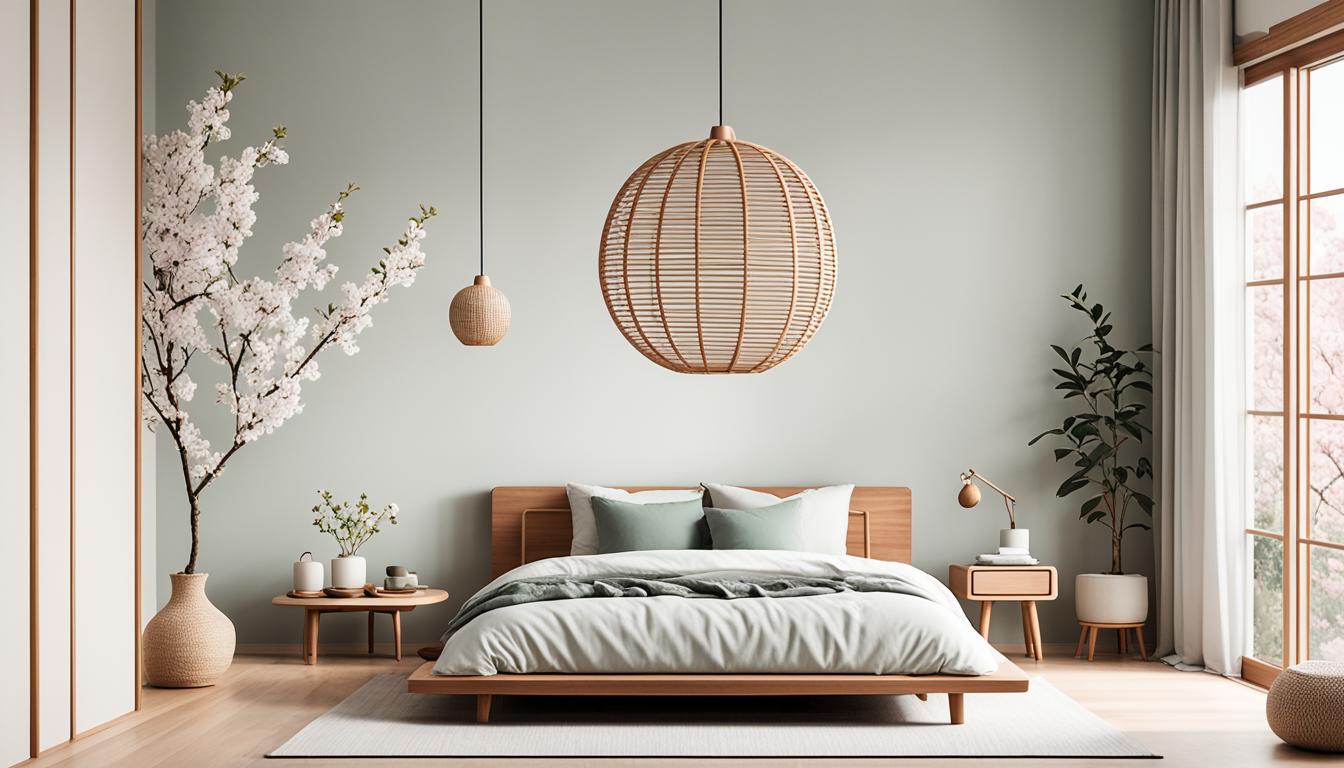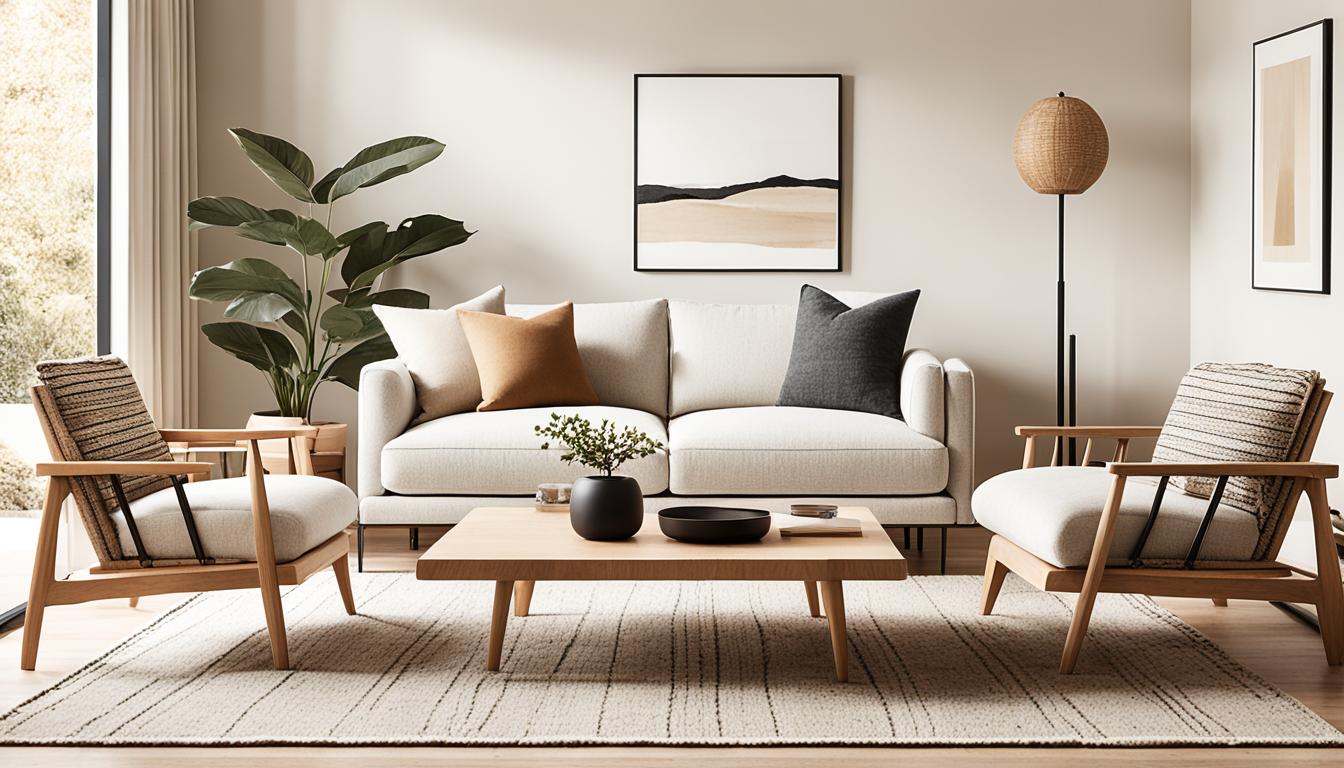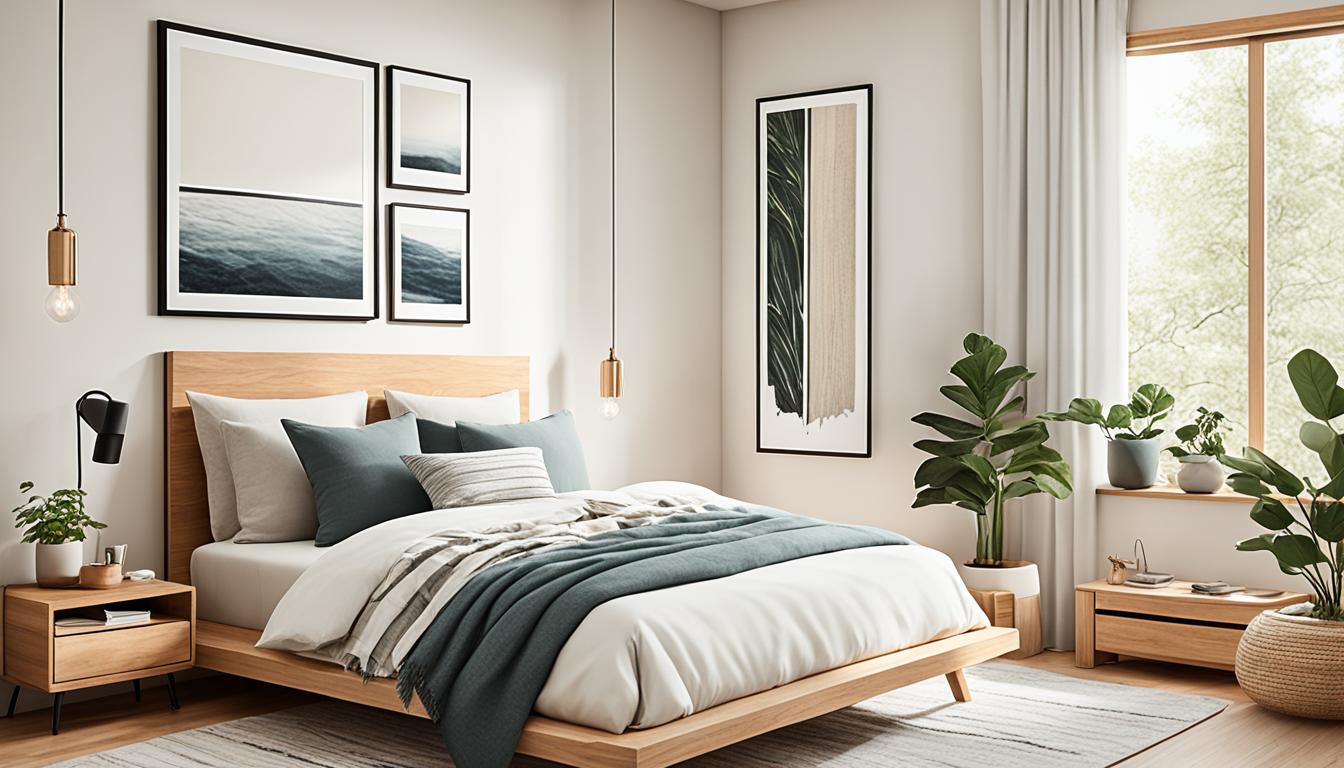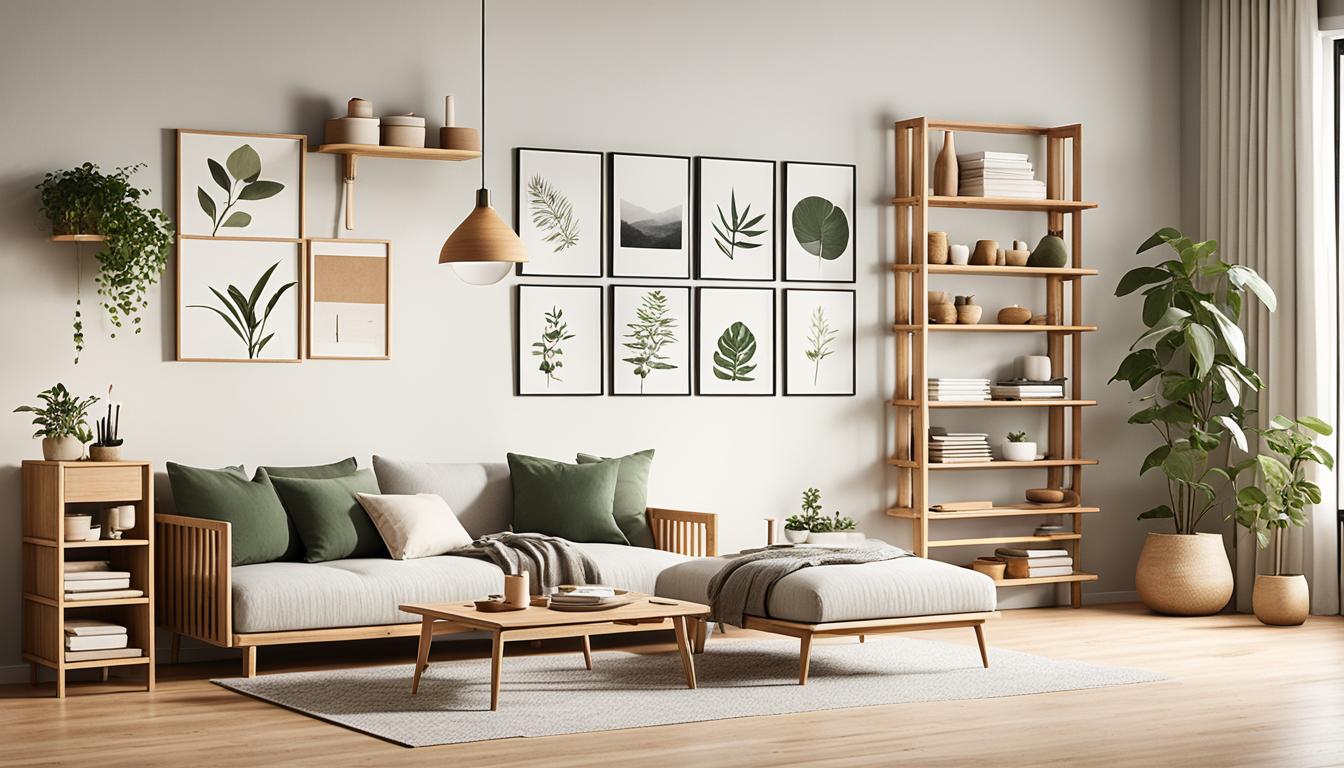🤍 Unmatched Quality, Authentic Craftsmanship
🤍 Unmatched Quality, Authentic Craftsmanship
🤍 Unmatched Quality, Authentic Craftsmanship
Welcome to our guide on Japandi small room ideas, where we will show you how to maximize your space and create a stylish oasis in even the tiniest of rooms.
Incorporating Japandi design principles allows you to embrace a minimalist interior design while adding a touch of tranquility to your living space.
Whether you're working with a compact bedroom or a small apartment, we've got practical tips and inspiring ideas to help you transform your small room into a cozy and functional haven.

In this section, we will delve into the concept of Japandi style, which is a fusion of Japanese and Scandinavian design principles.
Japandi style has gained popularity in recent years, combining the simplicity and minimalism of Japanese aesthetics with the clean lines and functionality of Scandinavian design.
Japandi style is characterized by its emphasis on simplicity, natural elements, and harmony.
It takes inspiration from the traditional Japanese concept of wabi-sabi, which celebrates the beauty found in imperfections, and the Scandinavian design philosophy of hygge, which focuses on creating cozy and comfortable spaces.
Scandinavian design is known for its clean lines, neutral color palettes, and emphasis on natural materials.
On the other hand, japanese-inspired design embraces simplicity, incorporates natural elements, and promotes a sense of tranquility.
When these two design styles come together, they create a unique aesthetic that is both calming and visually appealing.
The philosophy behind Japandi aesthetics is rooted in the idea of finding balance and harmony in the living environment.
It emphasizes the use of natural materials, such as wood and bamboo, to bring a sense of warmth and connection to nature.
Functionality is also a key aspect of Japandi design, with an emphasis on practicality and purpose in every element of the space.
In small Japandi rooms, choosing the right furniture can make a significant difference in maximizing space and creating a harmonious aesthetic.
By selecting space-saving furniture that fits the dimensions of your small room, you can create a functional and stylish space without compromising on comfort.
When it comes to Japandi furniture, minimalist design is key.
Opt for sleek and streamlined pieces that embrace simplicity and clean lines.
Look for furniture made from natural materials such as wood or bamboo, as they not only align with the Japandi aesthetic but also add warmth and organic textures to your small room.
To make the most of limited space, consider multifunctional furniture pieces.
For example, a sofa with built-in storage or a coffee table that doubles as a desk can provide practical solutions for small Japandi rooms.
These versatile pieces not only save space but also enhance the functionality of your room.
It's important to choose furniture that complements the overall design theme of Japandi interiors.
Opt for pieces that harmonize with the neutral color palette and minimalistic style of your small room.
Keep the furniture arrangement open and airy to create a sense of spaciousness and flow.

In small Japandi rooms, color palettes play a crucial role in creating a harmonious and visually pleasing environment.
By carefully selecting colors, you can maximize the impact of Japandi aesthetics and transform your small space into a serene sanctuary.
The foundation of Japandi interiors lies in the use of neutral tones.
Neutral colors such as soft whites, warm beiges, and light grays create a calm and tranquil atmosphere, allowing the natural textures and minimalist design elements to shine.
These neutral hues form the backdrop of your small room, providing a sense of openness and simplicity.
While neutral tones are key in Japandi interiors, incorporating color accents and accessories is essential to add depth and visual interest.
Consider incorporating pops of color through vibrant throw pillows, artwork, or small decorative objects.
These color accents can energize the space and create focal points, enhancing the overall aesthetic of your small Japandi room.
When choosing colors for small spaces, it's important to consider the impact of lighting and create a cohesive look.
Here are some tips to help you choose colors that complement your small Japandi room:
By following these tips and experimenting with different color combinations, you can create a beautiful and harmonious small Japandi room that maximizes the aesthetics of your space.
In Japandi decor, the integration of natural elements plays a crucial role in creating a harmonious and serene environment.
By incorporating organic materials such as wood, bamboo, and stone, you can enhance the Japandi aesthetic in small rooms, bringing a touch of nature indoors.

The use of wood adds warmth and a sense of natural beauty to Japandi spaces.
Whether it's in the form of furniture, flooring, or wall accents, the rich texture and earthy tones of wood create a grounding effect in small rooms.
Bamboo, on the other hand, adds a delicate touch with its light and sustainable properties.
It can be incorporated through furniture, room dividers, or even as a decorative element.
Stone, such as marble or pebble accents, adds a sense of luxury and timelessness to Japandi spaces.
Whether it's used as a backsplash, countertop, or even as a statement feature, stone brings a serene and natural ambiance to small rooms.
When choosing materials for Japandi decor, it's important to prioritize sustainable options.
Opt for organic designs that utilize sustainable materials, such as reclaimed wood or bamboo grown without harmful pesticides.
By making conscious choices, you can create a Japandi-inspired space that aligns with your values and contributes to an eco-friendlier lifestyle.
In small rooms, creating a sense of openness and flow is essential to maximize the space and embrace the Japandi design principles.
By strategically arranging your furniture, you can achieve a harmonious and functional layout that enhances the overall aesthetic.
Let's explore some key strategies for crafting open and flowy spaces in your Japandi-inspired room.
One of the fundamental aspects of Japandi furniture arrangement is the use of low-profile furniture.
These pieces not only contribute to the minimalist aesthetic but also create a sense of spaciousness.
Consider opting for sofas, coffee tables, and beds with lower profiles to open up the visual space in your room.
By keeping the furniture closer to the floor, you allow the room to appear more expansive and uncluttered.
In small rooms, every piece of furniture should serve a purpose.
Selecting multifunctional pieces is key to maximizing functionality without sacrificing style.
Look for furniture items that can serve multiple roles, such as storage ottomans, sleeper sofas, and nesting tables.
These versatile pieces not only save space but also add practicality to your Japandi-inspired room.
Incorporating room dividers can enhance the small space organization and flow of your Japandi room.
Room dividers serve as visual boundaries that define different functional areas while maintaining an open and cohesive design.
Opt for natural materials, such as bamboo or woven screens, that align with the Japandi aesthetic.
Additionally, consider using open shelving or bookcases as room dividers to provide storage while maintaining an airy feel.
In this section, we'll provide you with practical Japandi decor tips for small spaces, focusing on maximizing impact with minimal elements.
To create a stylish and functional Japandi-inspired small room, it's essential to strike a balance between simplicity and personalization.
Embracing Japandi aesthetics means saying goodbye to clutter.
Start by decluttering your small room and getting rid of unnecessary items.
Create a clean and organized space by utilizing storage solutions such as baskets, shelves, and hidden compartments.
Make the most of your small space by incorporating functional design solutions.
Consider furniture pieces that serve multiple purposes, such as a storage ottoman or a coffee table with built-in drawers.
Utilize wall space for hanging shelves, hooks, or a pegboard to maximize storage options.
Japandi style is all about simplicity and minimalism. Choose furniture and decor items with clean lines and a subdued color palette.
Opt for natural materials such as wood and bamboo to bring warmth and texture to your small room.
While keeping your decor minimal, it's essential to create visual interest in your small room.
Bring in pops of color through accent pillows, rugs, or artwork. Play with texture by adding a cozy throw blanket or pillows with different fabric finishes.
Lighting plays a crucial role in Japandi decor. Maximize natural light by keeping window treatments minimal or using sheer curtains.
Incorporate soft ambient lighting with pendant lights or table lamps.
Consider using dimmers to create a cozy and intimate atmosphere in the evenings.
Japandi design is heavily influenced by nature. Bring the outdoors inside by incorporating plants and greenery.
Choose sustainable materials and natural fibers for your furniture and textiles to create a harmonious and eco-friendly small room.
While simplicity is key in Japandi decor, it's essential to personalize your small room with meaningful decor.
Choose items that hold sentimental value or reflect your personality.
Display a few carefully chosen decorative pieces that bring joy and add a personal touch to the space.
By following these japanese and scandinavian decor tips, you can transform your small room into a unique and inviting sanctuary that maximizes space and embraces the beauty of minimalist design.

In Japandi design, lighting plays a crucial role in setting the right mood and enhancing the overall aesthetic of small rooms.
By utilizing the right lighting techniques, you can create a harmonious and inviting atmosphere in your Japandi-inspired space.
In this section, we will explore the key factors to consider when it comes to lighting in Japandi interiors, from leveraging natural lighting to choosing the perfect light fixtures and creating ambiance through layering light.
Natural lighting is an essential element in Japandi design as it promotes a sense of openness, tranquility, and connection to the natural world.
To maximize natural light in your small room, consider the following:
By harnessing the power of natural lighting, you can create a warm and inviting Japandi space that embraces the beauty of nature.
When it comes to artificial lighting in Japandi interiors, it's essential to select light fixtures that align with the overall aesthetic. Consider the following tips:
By carefully selecting light fixtures that complement the hybrid interior style, you can enhance the overall ambiance of your small room.
Layering light is an effective technique to create depth and ambiance in small Japandi spaces. Here's how:
By strategically layering light, you can create a multidimensional and cozy ambiance in your Japandi-inspired small room.
In our quest for creating beautiful and functional small spaces, we cannot overlook the importance of sustainability and eco-friendly design.
Japandi interiors provide an excellent platform to embrace a more conscious and environmentally friendly lifestyle.
By incorporating natural materials and opting for eco-friendly decor, we can contribute to a healthier planet while enjoying the beauty of Japandi design.
Using natural, renewable, and sustainable materials is a cornerstone of sustainable Japandi design.
By choosing furniture, flooring, and accessories made from wood, bamboo, and other organic materials, we can create a harmonious connection with nature.
These materials not only add warmth and texture to our small spaces but also reduce our carbon footprint and support environmentally conscious living.
Here's an example of how sustainable design choices can enhance Japandi aesthetics in small spaces:

| Design Choice | Impact |
|---|---|
| Using reclaimed wood for furniture | Reduces deforestation and promotes recycling |
| Opting for natural fiber rugs | Supports sustainable agriculture and reduces reliance on synthetic materials |
| Choosing organic cotton for bedding and curtains | Reduces pesticide use and supports ethical farming practices |
| Incorporating indoor plants | Purifies the air and brings nature indoors |
One of the key elements that sets Japandi design apart is the emphasis on texture.
Incorporating different textures in your small room can enhance the visual appeal and create a tactile experience that adds a subtle sense of luxury.
By combining smooth and rough textures, you can create a visual contrast that brings depth and interest to your Japandi-inspired space.
Japandi textiles play a vital role in achieving balance and harmony in minimalist decor.
From soft and cozy throws to woven rugs and textured curtains, incorporating Japandi textiles can add warmth and visual richness to your small room.
Choose natural fabrics like linen, cotton, and wool to align with the Japandi aesthetic and create a serene atmosphere.
When selecting fabrics for your Japandi-inspired small room, opt for materials that elevate the overall aesthetic while maintaining simplicity and functionality.
Consider using contrasting textures, such as pairing a smooth linen sofa with a chunky knit throw or combining a sleek leather chair with a plush velvet cushion.
This interplay of textures adds visual interest and sophistication to your minimalist decor.
| Texture | Examples |
|---|---|
| Smooth | Polished wood surfaces, sleek leather furniture |
| Rough | Woven rattan baskets, textured stone or ceramic accessories |
| Soft | Cozy throws, plush cushions, velvet upholstery |
| Chunky | Knit blankets, textured rugs, oversized woven wall hangings |
By carefully selecting fabrics that offer a variety of textures, you can create a space that is visually appealing and inviting.
Remember to balance contrasting textures with a cohesive color palette to maintain the harmonious Japandi aesthetic in your small room.
Now that you have read the above article, maybe you still have a couple of questions on this topic, so we will answer these questions below.
Japandi style is a fusion of Japanese and Scandinavian design principles, combining the minimalist aesthetics of both cultures to create a harmonious, functional, and tranquil living environment.
Some practical Japandi decor tips for small spaces include decluttering and creating a clean and organized environment, incorporating smart storage solutions, utilizing wall space, balancing simplicity and personalization, and incorporating different textures for a subtle sense of luxury.
If you're looking to spruce up your small room interior with modern decor, Mojo Boutique has got you covered.
When it comes to modern small room decor, functionality is key. That's why compact living ideas are so important.
So, if you're in search of functional small room design ideas and trendy decor pieces, make sure to check out Mojo Boutique for all your furnishing needs.
In conclusion, embracing Japandi design principles can be the key to transforming your small room into a functional and stylish sanctuary.
Throughout this article, we have explored various Japandi small room ideas, highlighting the importance of maximizing space and incorporating minimalist interior design.
By carefully selecting furniture pieces that are space-saving and align with the Japandi aesthetic, you can create an open and airy atmosphere.
Choosing a color palette that embraces neutral tones while incorporating color accents and accessories can further enhance the Japandi aesthetic in small spaces.
Integrating natural elements such as wood, bamboo, and stone can bring a sense of tranquility while promoting sustainable and environmentally conscious living.
Additionally, strategically arranging furniture, decluttering, and incorporating functional design solutions can maximize the impact of your Japandi-inspired small room.
As we conclude, we invite you to embrace the Japandi style and unleash your creativity.
With these small space solutions and Japandi design principles, you have the power to transform your small room into a personalized oasis that perfectly balances simplicity and functionality.


